
|
BOP's 50 Favorite Horror Films: Top Ten
10) The Exorcist
9) Psycho
--As sacrilegious as it was, when someone decides to make a shot-by-shot remake of your film, you did something right the first time. Not Hitchcock's best work (though it's in the top three), but certainly his best film that qualifies as horror, Psycho remains famous for many reasons. Is it the famous theme? The shower scene? Anthony Perkins with the Creep-O-Meter cranked to 11? The amazing direction and imagery? It's everything. Many other films have tried to duplicate what was captured here (including the aforementioned ill-fated remake), and all have failed. (Tim Briody/BOP) --Perhaps not as outright scary as some other horror movies, but a groundbreaking film that broke many rules, and in the process created new ones for the genre. (Dan Krovich/BOP) -- Alfred Hitchcock's career spanned many genres, from thriller to comedy to suspense to horror. But Psycho stands alone in terms of cultural impact, and is rivaled only by The Birds in terms of out-and-out scares. Starring a cast of mostly little-known actors - the only name star, Janet Leigh, dies in the first reel - Hitch created a creepy atmosphere and a protagonist who seems almost too helpful and charming to be true. From the infamous shower scene to the unforgettable image of the swinging light bulb, to the final, eerie shot of Anthony Perkins, Psycho is part flat-out horror film, part psychological study, and all good. And I defy anyone to watch this film and then try and take a shower, alone, at night. Especially with only a shower curtain between you and...whatever may lurk in the darkness. (Stephanie Star Smith/BOP) --Although the impact of a man dressing up in his mother's clothes has lessened since the 1960s, the power of a film like Psycho to thrill has not. Few movies have as many scenes or elements that are remembered 40 full years after its release. The shower scene. Mother's house. The parlor room full of stuffed birds, all looking ready to pounce. That endlessly copied score. More than just a collection of Hitchcock's greatest hits, though, it's a tense thriller that never fails to put its audience at ease. All modern horror films owe some debt to Psycho. (Reagen Sulewski/BOP)
8) Dead by Dawn: Evil Dead 2
Jack Black's character in High Fidelity immortalizes exactly what works about this terrific sequel. It's gross and disgusting, with lots of bloody and revolting characters, and of course, we have the return of the inimitable Bruce Campbell as Ash. Not only does he wind up fighting a host of Deadites, but he is forced to battle his own possessed hand when it goes bad (in one of the most famous scenes in recent horror film history). It's easy to see director Sam Raimi's growth from the 1982 original to the sequel, which hit limited theaters in 1987 and was made on a $3 million budget. He became daring in his use of creative camera shots (a continued trademark for the director) and the atmosphere created in the creepy house in the woods is truly remarkable. The final result is a film that is campy, scary, hilarious and over-the-top, with numerous movie and comic-book allusions that will thrill fan-boys. Groovy. (Kim Hollis/BOP) --Five years after Sam Raimi took the horror world by storm with The Evil Dead, he decided to return to the series with a sequel/remake. With original lead, Bruce Campbell, they decided to keep the very simple plotline (Ash battles zombies in a remote cabin) but increased the humour quotient; homages to The Three Stooges and other classic comedies abound. There are a few new characters introduced in this movie, and a bit more of a plot (it explains why he can't just leave the cabin), but for the most part, it's 90 minutes of gore and zombie-destroying action. Stylish in the extreme, it dares you not to laugh at its excess. When you're not laughing, you'll jump at the carefully prepared scares. (Reagen Sulewski/BOP) --This middle film in the Evil Dead trilogy is, to my mind, the best of the three. And I will now pause while all the Army of Darkness fans go get their boom sticks. My reasoning is thus: Evil Dead set up the characters and the basic plot, and while it was an interesting film, it wasn't really all that unique in the horror field. Army of Darkness is flat-out camp, albeit some of the best black-comedy-tinged camp around and sporting a plethora of the most quotable lines in the horror pantheon, but still, at its core, camp. Evil Dead 2 is the perfect combination of the two, blending the horror elements of the first with some of the black comedy of the third in such a way that even while laughing, the audience is still creeped to the max. The resulting mix of the two genres creates a film that will scare the pants off you just in time to keep you from wetting them with laughing. Hats off to Sam Raimi for the successful amalgamation of two such diverse genres. (Stephanie Star Smith/BOP)
7) Dawn of the Dead
Whether or not it was cause-and-effect or just one of the most memorable examples, Dawn of the Dead was one of the first instances of the shift in the locale of horror, away from the dusty old crypts and isolated houses to a more recognizable setting that played a big part in the urbanization (and possibly the popularization) of horror as a genre through the '80s and '90s. (Ash Wakeman/BOP) --This second in George Romero's Living Dead trilogy finds the director with a bigger budget, and a taste for re-inventing some more staples of the zombie movie. Instead of taking place in a foggy bog or some Caribbean island, Dawn of the Dead takes place in a shopping mall, and the humans trying to keep the cannibalistic dead at bay are nearly as screwed up mentally as the zombies they are battling are physically. Dawn takes a look at the psychological toll that a paradigm shift can take on those experiencing it, and how the will to survive sometimes rings hollow when the world in which one is fighting to remain no longer seems to make much sense. Dawn of the Dead not only provides the perfect transition from the gruesome battles in Night of the Living Dead to the bleak world of the remaining living in Day of the Dead, but also shows how the director has grown as a talent in the genre. (Stephanie Star Smith/BOP) --I discovered Dawn of the Dead in high school, after being traumatized by seeing Tom Savini’s infinitely disgusting special effects in 1985’s Day of the Dead in the movie theater. Having already seen Night of the Living Dead, it was only natural that I complete my viewing of the trilogy, albeit in convoluted order. To this day, Dawn of the Dead remains one of the best horror films I have ever seen. It has literally everything for the hard-core fan. Zombies? Check. Over-the-top special effects? Absolutely. A claustrophobic and desperate setting? Certainly, as the shopping mall provides the perfect unlikely scary movie location. The ingredients combine for a sublime and terrifying experience that is nearly impossible to duplicate. (Kim Hollis/BOP)
6) Alien
While the film excels on many levels, it is the Giger-designed titular alien that steals the show. Its impressive array of defenses and armaments, and its startling life cycle have been explored to death in an array of sequels and tie-ins, but never so effectively as the crew of the Nostromo gradually realizing what they were up against as they were picked off one by one with ease by a superior life form. The true beauty of Alien is that on one hand, it is directing a genre-defining monster movie, while on the other it is giving us an outstanding science-fiction film. At the end of the film, we are left not only with an iconic movie monster but one of science fiction's most memorable characters in Sigourney Weaver's Ripley.(Ash Wakeman/BOP) --Besides being very scary, it also provided one of the best and most memorable taglines for a movie ever: "In space no one can hear you scream. (Dan Krovich/BOP) --One of the most singularly fearsome movie creations ever realized. Ridley Scott's second film is his second masterpiece; visually stunning and narratively gripping. Straightforward, relentless; by the end, you just want mercy. (Alex Hudson/BOP) --"In space, no one can hear you scream." The tagline and the stark poster were all we had to prepare us for one of the most gripping, frightening and psychologically exhausting monster film of its - and perhaps all - time. Ridley Scott, a then-unknown director just hitting his stride, created the archetypal deadly-stalker monster film with his tale of the ill-fated crew of the Nostromo, who learn the hard way that sometimes, it's better not to explore the big, deserted-looking ship on the seemingly-dead planet. And really; was anybody who saw this film able to eat spaghetti afterwards without being just a bit worried? (Stephanie Star Smith/BOP) --This is the movie Ridley Scott made just before he became Ridley Scott. Released in a sea of movies made to cash in on the sci-fi and horror crazes of the late'70s, Alien was a cut far above the rest. All the right ingredients are there - a dark, technorganic visual style grafted from the work of H.R. Giger (who until that time had been best known for his album cover art, like Emerson Lake and Palmer's Brain Salad Surgery); Jerry Goldsmith's brooding score; Sigourney Weaver's brilliant turn as the willful Ripley (still the only female action hero worth watching); and Scott's deft management of the creeping doom as a space crew becomes prey for an unstoppable monster with nasty, big, pointy teeth. The Oscar-winning effects include the now-legendary scene where John Hurt realizes that he's been gestating an alien foetus and, before anyone can administer an epidural, he, um, gives birth. Through his stomach. Brain salad, anyone? (Tad Roebuck/BOP)
5) Halloween
But Michael made the others possible, and created a horror franchise that is still going strong (Halloween: Resurrection, Michael's eighth trip to the cineplex, brought in more than $30 million at the box office earlier this year, with more to surely come in the home-video market) 30-some-odd years after the release of a low-budget genre film that shifted the paradigm and created a pop-culture icon in the process. (Stephanie Star Smith/BOP) --The real catalyst of the slasher sub-genre that came to dominate horror in the ‘80s, for better or worse. John Carpenter's film was definitely for better. Provided what I still use as a standard today to determine if a movie really scared me. When I get in my car to drive home, if I check my backseat, it scared me. (Dan Krovich/BOP) --Jason Voorhees and Freddy Krueger owe their undead lives to Michael Myers. John Carpenter's masterwork laid the groundwork for an entire sub-genre. (Alex Hudson/BOP) --Paving the way for the slasher flick, Halloween stands out as the scariest of its type. John Carpenter, ever stylish, created a grim reality where serial killers might not ever die, a terrifying and nightmarish concept. It’s no coincidence that Michael Myers is considered an icon of the American horror film. He’s a killer without conscience, without even a comprehensible or logical driving force. A merciless spectre whose face remains hidden from his victims, he feeds on fear and exists to destroy. Since uncertainty and futility are entirely disconcerting, Halloween holds up extremely well almost 25 years after it was first released, and continues to spawn sequels that somehow manage to attract a following at the box office. (Kim Hollis/BOP) --One of the reasons this film is so popular is because it hits its fans right where they live - in suburbia. Fifteen years after a young Michael Myers is institutionalized for committing murder, he escapes to return to said 'burbs - and pick up where he left off. The suspense burrows deep into your skin and leaves behind a terror that stays with you well after the film is over. Director John Carpenter and co-writer Debra Hill could not make lighting strike twice when they tried their hand at scripting Halloween II, but that didn't stop about a dozen other filmmakers from trying. Though it is the father of any number of bastard sons, don't let the blatant money-mining franchise that bears the name "Halloween" dissuade you from seeing the original. (Tad Roebuck/BOP)
4) The Haunting (1963)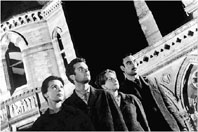 The Haunting is that rarest of beasts, an excellent novel that was turned into a film that just about matches the quality of its printed source. Adapted from Shirley Jackson's quietly frightening evil house novel, The Haunting of Hill House, this 1963 film preserves the unsettling nature of the book without resorting to the sort of absurd plot alterations that plague the execrable and better-off-forgotten 1999 version. The plot itself is essentially simple; a scientist who is studying paranormal phenomena at an old mansion with a checkered history gathers together a group of people to examine if the place really does have manifestations of a ghostly nature.
The Haunting is that rarest of beasts, an excellent novel that was turned into a film that just about matches the quality of its printed source. Adapted from Shirley Jackson's quietly frightening evil house novel, The Haunting of Hill House, this 1963 film preserves the unsettling nature of the book without resorting to the sort of absurd plot alterations that plague the execrable and better-off-forgotten 1999 version. The plot itself is essentially simple; a scientist who is studying paranormal phenomena at an old mansion with a checkered history gathers together a group of people to examine if the place really does have manifestations of a ghostly nature.
Besides the professor (Richard Johnson), the group consists of a young man who is heir to the place (Russ Tamblyn), and two empaths: the enigmatically catty and possibly bisexual Theo (Claire Bloom), and the mousy and shy Eleanor (Julie Harris). There are a couple of other characters who put in appearances (notably the cranky old housekeeper who utters the cryptic warning "No one can hear you scream...in the night...in the dark"), but for the most part it's these four against the house for the duration of the film. As directed by prolific filmmaker Robert Wise, the eponymous domicile becomes a looming, intimidating presence that dominates the film. While it wouldn't be much fun to detail exactly what occurs for those readers who have yet to see this gem, suffice it to say that the goings on are both creepy and shiver-inducing. There are few places where people feel safer than in their homes, so the idea of the physical framework that encapsulates our domestic life viciously turning upon its inhabitants makes for frightening fare. Also especially of note is the seemingly predatory nature of Hill House itself; just like a hunting beast, it decides to single out the weakest member of the group on which to concentrate its horrible intentions. From start to finish, the director slowly builds the eerie tension of this horror classic until it reaches its shattering conclusion. While the story is condensed some from the plot of the book, it maintains all its essential elements, and even the minor changes that are made seem to enhance the clarity of the film without marring the original themes of the story in any way. A first-class production on all fronts, this timeless ghost story may have been made four decades ago but it still remains one of the all-time I'm-gonna-sleep-with-the-lights-on-after-this films. There are few ghosts tories ever made for the cinema that can even compare. (Chris Hyde/BOP)
3) Nightmare on Elm Street
--I vividly remember seeing this film for the first time. It was a double-feature with the newly-released Terminator, and my date and I went several weeks quoting from and talking about both movies. We also went back to see Nightmare on Elm Street three times; it was so scary that it was a visceral and perversely enjoyable experience. To this day, I occasionally have Freddy Krueger nightmares of my own. (Kim Hollis/BOP) --Though some of the sequels drifted into camp and comedy, the original was truly frightening. Its genius is the idea of a villain who preys on his victims in the place where they are most vulnerable: in their dreams. (Dan Krovich/BOP)
2) The Evil Dead
Evil Dead may hold a bit more importance in my mind than some other films of the genre simply because it was the movie that allowed me to discover Bruce Campbell. He wasn’t a famous actor at the time, but I remember being thrilled by the unique fact that this was the first splatter film I had ever seen that had a male survivor (as opposed to a screaming female). Made on a budget less than $700,000 (with funding from an odd variety of sources), Evil Dead was the first feature film collaboration for director Sam Raimi and his executive producer cohorts Campbell and Rob Tapert (AKA Mr. Lucy Lawless). Since they had such limited funding, the gang used local Detroit-area actors and a remote East Tennessee filming location. Somehow, all of the elements combined for the perfect combination of schlock, gore and horror. The images of the trees being bent over completely by an unknown malevolent force are terrifying, but even more so is the slow and torturous process of becoming one of the Evil Dead. Part of the brilliance of the story is that the individual Deadites have very distinct personalities; one is pure violence, one is childishly manipulative, and all are exquisitely dangerous and lethal. And did I mention that it has Bruce Campbell? (Kim Hollis/BOP) --One of the first rules of horror films is that if you find something called The Book of the Dead, you're probably better off just leaving it alone. Unfortunately for the characters, but fortunately for us, they never ever do. Shot in 1979 on what amounts to one week's catering budget for a Hollywood movie, The Evil Dead is one of the more remarkable horror films ever made. Sam Raimi, only 23 when he made this, throws every directing trick in the book at the screen and even introduced a new one: The Sam-Ram-a-cam, which basically invented the idea of "shaky-cam". At times you won't believe what you're seeing on screen and how he got away with what he did. Even jaded horror viewers can be a little off-put at how the forest "takes advantage" of one of the characters in the film. This series also introduced B-actor extraordinaire Bruce Campbell to the world, and his square-jawed presence and natural humor adds another dimension to the film. Never boring, this film was a landmark for independent filmmaking and proved that cheapness in budget doesn't have to mean cheapness in style. (Reagen Sulewski/BOP) --Well, the premise seems generic enough: a group of college students take a long weekend in an isolated mountain cabin. Of course they are going to unleash some kind of unholy terror and start dying horrible deaths. Well, The Evil Dead is not the rote exercise you might expect - if it was, then director Sam Raimi and this film (his first full-length feature) would have vanished into obscurity then and there. Instead, the tried-and-true formulas get new twists with some extraordinarily innovative camerawork and genuinely eerie scares that even the worst acting and the cheapest special effects cannot dampen. The film had no budget, but boy does it have spunk, and ya gotta like that. (Tad Roebuck/BOP)
1) The Shining
Ambiguity abounds; motifs like doubling and obliteration of the oppressed are hinted at but not fully developed. Over 20 years later, Kubrick's film is still a deliberately impenetrable mind fuck. (Alex Hudson/BOP) --This movie freaked me out when I was a teenage girl, before I understood the brilliance of its many parts. All I knew was that Jack Nicholson was crazy creepy; I was always afraid he was going to jump out of the bushes in our backyard when I was taking the dog out in the evenings. Today, I can appreciate the film on an even deeper level. Naturally, Nicholson’s performance is over-the-top and characteristically fantastic, as he masterfully portrays the slowly growing derangement of his helplessly isolated character. The cinematography and direction are amazing, showing Stanley Kubrick’s classic and distinctive aspects of distance and expansiveness that are consistently present in his work. The savage, icy world surrounding the Overlook Hotel looks almost alien, and serves to make the characters look small and insignificant in comparison. Ultimately, Kubrick does a remarkable job of tying together the various thematic elements; Jack’s gradual detachment from his family as he takes the time to listen to the imprints from the past that remain in the hotel, Danny and Dick’s “shining” connection, and even Wendy’s utter helplessness all combine for a desperately frightening tale that feeds on all of our basest fears. (Kim Hollis/BOP) --Stephen King has made no bones about he fact that he hates Stanley Kubrick's screen adaptation of his novel - too long, not faithful enough to the book, blah blah blah. Well, now that King's made-for-TV remake has tanked, maybe he'll just stand aside and let us continue heaping praise upon this masterpiece. Jack Nicholson plays a writer who brings his family on a job, house-sitting a mountaintop hotel during the snowy off-season. While Nicholson's character slides into a serious case of cabin fever, his son sees dead people. Other than the serious misstep of casting Shelley Duvall as Nicholson's wife (you might very well mistake her for a marionette), this film is a truly dark masterpiece. Kubrick's obsessive perfectionism and keen attention to detail is in full force, and the cold, clinical isolation he brings to nearly all of his images is the perfect otherworldly touch for this film. (Tad Roebuck/BOP)
Click here to read selections 41-50.
|
Thursday, December 18, 2025
© 2006 Box Office Prophets, a division of One Of Us, Inc.
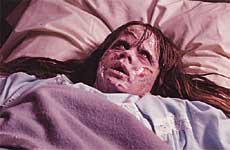 Epic struggles between good and evil don't get much more intense than God and the Devil fighting a proxy power struggle through the souls of a few Earthly vessels. That's the sort of premise that is sure to crush any movie under its weight. The Exorcist not only holds it up brilliantly, but it has managed to retain all of its power to remain relevant, influential and shocking 30 years after it was made. Much of that shock comes from the progressively nasty ways a young girl's demonic possession manifests itself. Those scenes - grounded as they are in meditations on faith, good, evil, and innocence - are probably the closest thing to genuine holy terror
that has yet to be captured in a dramatic film. William Friedkin's direction, William Peter Blatty's script, and the performances delivered by Ellen Burstyn and Jason Miller are all examples of moviemaking at its most powerful. (Tad Roebuck/BOP)
Epic struggles between good and evil don't get much more intense than God and the Devil fighting a proxy power struggle through the souls of a few Earthly vessels. That's the sort of premise that is sure to crush any movie under its weight. The Exorcist not only holds it up brilliantly, but it has managed to retain all of its power to remain relevant, influential and shocking 30 years after it was made. Much of that shock comes from the progressively nasty ways a young girl's demonic possession manifests itself. Those scenes - grounded as they are in meditations on faith, good, evil, and innocence - are probably the closest thing to genuine holy terror
that has yet to be captured in a dramatic film. William Friedkin's direction, William Peter Blatty's script, and the performances delivered by Ellen Burstyn and Jason Miller are all examples of moviemaking at its most powerful. (Tad Roebuck/BOP)
 --The expressionless face, the decrepit wig. The mental picture of Norman Bates as Mother is chillingly creepy. Hitchcock pours all his fears into this picture: fear of authority, fear of loneliness, fear of death. Hitch was fond of abandoning his viewer in a confined locale - Rear Window, Dial M for Murder, Rope, Lifeboat come to mind - but with Psycho, the isolationism of the Bates motel is claustrophobic to the degree it is upsetting. (Alex Hudson/BOP)
--The expressionless face, the decrepit wig. The mental picture of Norman Bates as Mother is chillingly creepy. Hitchcock pours all his fears into this picture: fear of authority, fear of loneliness, fear of death. Hitch was fond of abandoning his viewer in a confined locale - Rear Window, Dial M for Murder, Rope, Lifeboat come to mind - but with Psycho, the isolationism of the Bates motel is claustrophobic to the degree it is upsetting. (Alex Hudson/BOP)
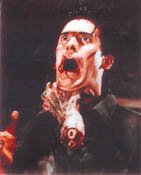 --"It's a brilliant film! It's so funny and violent, and the soundtrack kicks fucking ass." -Barry, High Fidelity
--"It's a brilliant film! It's so funny and violent, and the soundtrack kicks fucking ass." -Barry, High Fidelity
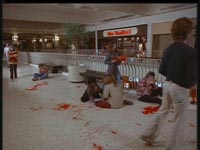 --In Dawn of the Dead, George Romero takes a hoard of zombies (a horror staple he had made his own) and transplants them from the traditional haunted houses and graveyards to an unremarkable suburban shopping mall. In doing so, he spawned an undead army of imitators and parodies, not to mention an entire videogame genre.
--In Dawn of the Dead, George Romero takes a hoard of zombies (a horror staple he had made his own) and transplants them from the traditional haunted houses and graveyards to an unremarkable suburban shopping mall. In doing so, he spawned an undead army of imitators and parodies, not to mention an entire videogame genre.
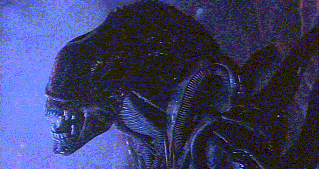 --The story of an isolated group of people being picked off one by one by an unknown and deadly menace is one of the biggest horror clichés around. In Alien, the familiar scenario is transferred into the depths of space and under the watchful eye of the then-relatively unknown Ridley Scott somehow manages to transcend both genres. Scott had a lot of help. A fine ensemble cast, a solid story, excellent production and art design and one of the most original and memorable movie monsters ever.
--The story of an isolated group of people being picked off one by one by an unknown and deadly menace is one of the biggest horror clichés around. In Alien, the familiar scenario is transferred into the depths of space and under the watchful eye of the then-relatively unknown Ridley Scott somehow manages to transcend both genres. Scott had a lot of help. A fine ensemble cast, a solid story, excellent production and art design and one of the most original and memorable movie monsters ever.
 --Michael Myers was the first of the mysterious-killer-who-seems-indestructible slasher sub-genre. Before Jason Voorhees, even before good old Freddy Krueger, John Carpenter brought us this tidy little horror film that launched Jamie Lee Curtis' screen career - not to mention keeping her a Scream Queen for a number of flicks - as well as Carpenter's own. It also helped establish the rules of the slasher game, rules that have become so well-known and clichéd, even for moviegoers who've never seen a single slasher film, that Wes Craven and Kevin Williamson were able to exploit the rigidity of the construct to great success in the Scream franchise.
--Michael Myers was the first of the mysterious-killer-who-seems-indestructible slasher sub-genre. Before Jason Voorhees, even before good old Freddy Krueger, John Carpenter brought us this tidy little horror film that launched Jamie Lee Curtis' screen career - not to mention keeping her a Scream Queen for a number of flicks - as well as Carpenter's own. It also helped establish the rules of the slasher game, rules that have become so well-known and clichéd, even for moviegoers who've never seen a single slasher film, that Wes Craven and Kevin Williamson were able to exploit the rigidity of the construct to great success in the Scream franchise.
 --Probably one of the most unique horror-film concepts to come down the pike in...oh, maybe ever, Nightmare on Elm Street plays off that old wives' tale that if you die in your dreams, your waking life also comes to an end. Of course, Nightmare on Elm Street takes it a couple steps further by giving the Grim Dream Reaper a sarcastic personality and pretty damned good motivation, and having him create all sorts of gruesome ways of sending his victims to meet their Maker. With the exception of the third film in the series, the sequels were - as sequels are wont to be - nothing more than pallid attempts to once again catch lightning in a bottle. But Freddy Krueger and Company will always have a special place in Horror Valhalla for this innovative and scary look at the things that go bump in the night that should really, really worry you. (Stephanie Star Smith/BOP)
--Probably one of the most unique horror-film concepts to come down the pike in...oh, maybe ever, Nightmare on Elm Street plays off that old wives' tale that if you die in your dreams, your waking life also comes to an end. Of course, Nightmare on Elm Street takes it a couple steps further by giving the Grim Dream Reaper a sarcastic personality and pretty damned good motivation, and having him create all sorts of gruesome ways of sending his victims to meet their Maker. With the exception of the third film in the series, the sequels were - as sequels are wont to be - nothing more than pallid attempts to once again catch lightning in a bottle. But Freddy Krueger and Company will always have a special place in Horror Valhalla for this innovative and scary look at the things that go bump in the night that should really, really worry you. (Stephanie Star Smith/BOP)
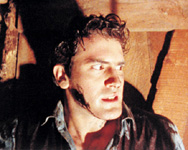 --No horror movie has ever effected me as much as this low-budget, campy piece of work. I originally saw the film when it was first released on video (face it, nobody saw it in the theater) with a bunch of friends, and we rented it fairly regularly from that point forward. The movie was scary and outrageous and I loved every bloody minute of it.
--No horror movie has ever effected me as much as this low-budget, campy piece of work. I originally saw the film when it was first released on video (face it, nobody saw it in the theater) with a bunch of friends, and we rented it fairly regularly from that point forward. The movie was scary and outrageous and I loved every bloody minute of it.
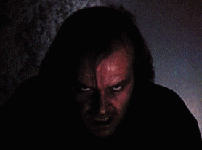 A father trying to butcher his wife and son. It simply doesn't get any more horrifying than that. Stanley Kubrick's maze of terror works on conscious and subconscious levels, as his jarring cutting and dissonant music help weave a disorienting tale of the disintegration of family. Is Jack Torrance's descent into madness triggered by the Overlook hotel, or does Jack's mental collapse allow the festering evil of the Overlook to be unleashed?
A father trying to butcher his wife and son. It simply doesn't get any more horrifying than that. Stanley Kubrick's maze of terror works on conscious and subconscious levels, as his jarring cutting and dissonant music help weave a disorienting tale of the disintegration of family. Is Jack Torrance's descent into madness triggered by the Overlook hotel, or does Jack's mental collapse allow the festering evil of the Overlook to be unleashed?